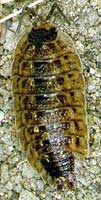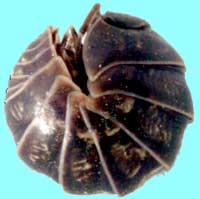
Are Sowbugs & Earwigs
Beneficial to a Garden?
"Big earwigs on the green,
The largest ever you seen."
-James Joyce
(1882-1941)
(1882-1941)
In the well-balanced organic garden, sowbugs & earwigs are beneficial insects. But if something occurs to throw the garden out of balance, so that their populations increase to the point of dominance in some areas of the garden, they can begin to eat seedlings & do miscellaneous plant damage.
An explosive sowbug population is evidence of something wrong in the garden, usually related to insecticide use. Woodlouses survive most insecticides & slowly expand their environmental niches if other niches are left empty when the natural balance in the garden is upset & sowbugs no longer have competition from true insects.
 Sometimes the garden imbalance is caused by planting too few types of plants -- the all-rose or all-dahlia gardens are inherently imbalanced hence subject to all sorts of insect attacks. Adding groundcovers, border perennials, & so on, makes for a prettier garden & one that is capable of attracting a wide & balanced array of helpful insect life. But most often the imbalance is the result of continuous pesticide & herbicide & fungicide stresses on the garden.
Sometimes the garden imbalance is caused by planting too few types of plants -- the all-rose or all-dahlia gardens are inherently imbalanced hence subject to all sorts of insect attacks. Adding groundcovers, border perennials, & so on, makes for a prettier garden & one that is capable of attracting a wide & balanced array of helpful insect life. But most often the imbalance is the result of continuous pesticide & herbicide & fungicide stresses on the garden.Earwigs are further falsely accused of entering the ears of sleeping individuals by night & laying eggs in human brains. The actual origin of their name is from the Saxon ear-wicga, "Ear Insect," named because the pincer-like hind end of the earwig was thought to resemble a human ear.
Sowbugs, woodlouses, pill-bugs, or rollypollies are crustaceans rather than insects & often impervious to insecticides. They sometimes get blamed for eating their way into tuburous vegetables or into eggplants & such, but mainly they are opportunistic, & enter the holes left by insect larvae, then get blamed for the damage when they were actually seeking primarily to eat the decaying rather than fresh part of the vegetable.
 Their preferred diet is dead matter so that they assist in reducing mulches & leaf litter to plant nutrients. They are are not good at digesting living plant material therefore will not attack healthy plants if there is not some generally unwholesome imbalance in the garden. One important exception is in moist greenhouses. The moisture provides ideal conditions for their breathing requirements (they have gills rather than lungs & will suffocate without moisture). Because greenhouses are generally pretty clean of garden rubble, the sowbugs have no option but to attempt to obtain nutrients from seedlings. Even in this case, if the garden outside the greenhouse is in good balance, sowbugs will not be so inclined to move into greenhouses where their preferred food resources are slim.
Their preferred diet is dead matter so that they assist in reducing mulches & leaf litter to plant nutrients. They are are not good at digesting living plant material therefore will not attack healthy plants if there is not some generally unwholesome imbalance in the garden. One important exception is in moist greenhouses. The moisture provides ideal conditions for their breathing requirements (they have gills rather than lungs & will suffocate without moisture). Because greenhouses are generally pretty clean of garden rubble, the sowbugs have no option but to attempt to obtain nutrients from seedlings. Even in this case, if the garden outside the greenhouse is in good balance, sowbugs will not be so inclined to move into greenhouses where their preferred food resources are slim.Earwigs in a balanced garden are also harmless. Although it is widely claimed (not by experts) that they are a significant hazard to healthy plants, they are in reality rarely inclined to eat healthy living plant matter. The naturalized common brown european earwig which most American gardeners encounter eats primarily dead leaf matter & dead insects -- like the woodlouse, they are scavengers first & foremost. A few other species of earwig are predatory & highly beneficial, catching living insects, especially aphids, spitbugs, snail eggs, & newly hatched slugs.
As many gardeners are going to leap up screaming, "Earwigs are bad!" I will note that one source on this is Richard Fagerlund of the University of New Mexico Environmental Services, Physical Plant Department (writing for Scripps Howard News Service & for Home & Garden). His data shows that the horror of earwigs in the garden is not justified. Any other knowledgeable specialist will in the main agree.
But there is that big "However":
Earwigs just like sowbugs can explode in population after insecticide use or other horrific interuption in a healthful organic balance of a garden. Because they are quickest to bounce back after toxification of a garden, they can take over more of a garden & begin to fill the niches of other insects. As with the generally harmless woodlouse, when all other insect life has been discouraged through repeated poisoning of the garden, the earwig will broaden its behavior patterns & begin to feed on healthy plantlife, especially seedlings & starts of things, sometimes on fresh buds.
In the unbalanced & often poisoned garden then, earwigs do indeed climb up into plants in the middle of the night & can defoliate young fragile things.
This explains why so many gardeners hate them, but such gardeners should instead hate themselves for unwholesome gardening practices that lead to such imbalances. Earwigs that veer away from their natural tendency to scavenge or catch aphids & baby slugs, & which begin to eat more living plants instead of their preferred diets, are giving evidence of bad gardening technique.
Here are the primary methods of controlling earwigs & sowbugs so that they remain helpful scavangers & leaf-mold manufacturers rather than plant eaters:
1) Both earwigs & wood louses need moist tight areas to persist. Sweeping up wood mulches, getting rid of wood piles, & general clean-up, gives them fewer places to hide & breed. Also keep compost piles away from the main gardens.
2) Avoid pesticides & encourage a natural balance of insects with increasing numbers of predator insects. If you must use pesticides, do not permit the pesticides to come in contact with the garden, where beneficial insects will be the first killed, & harmful insects will be the first to bounce back. Take small milk cartons (or similar waterproof carton) & poke holes in the sides with pencil. Bait the box with bran & oatmeal or cream of wheat -- mixed with a powdered insecticide which states explicitely that it can kill earwigs. This is not the most recommended because ants & other insects may disperse the poisoned bait into the garden, but I know that toxin-reliant gardeners need to wean themselves & it's hard for them to go cold turkey, so the bait-box method is a bridging technique to going fully organic.
3) Encourage birds, which eat earwigs as though they were candy. Also encourage frogs & toads if you're in an area where that is possible.
4) Place a half-inch or an inch of cooking oil in a pop-can or a jar, & sink the jar halfway in the ground or lay the can on its side with the key-hole spout upward so the oil won't run out. Oily tunafish cans or catfood cans are short enough they wouldn't have to be sunk in the ground at all. Earwigs can climb glass & metal very easily, & will be interested in the odor of the oil. They will drown themselves by the hundreds in the half-inch of oil, which you will have to clean out every three or four days. You will know the first morning how well it's working.
5) Earwigs seek cover by daylight. Place two-foot-long scraps of soaker hoses around the bases of plants that have shown signs of earwig attack. Every morning, empty the earwigs out of the lengths of hose into vinegar or soapy water (the common recommendation to just drown them is folly; they can live underwater for half a day, & can climb out any time they want. Gilled sowbugs can survive underwater for several days, & leave at will).
6) Or, lightly dampen loose rolls of newspapers & place those near plants that are at risk. At dawn the earwigs will take cover in the newspaper rolls, which can daily be tightly wrapped in plastic grocery bags & discarded.
7) Plant Purple Pitcher Plants (Sarracenia purpurea ) in a boggy sun-garden. This is a prostrate pitcherplant & it catches primarily sowbugs but also beetles & earwigs. Each pitcher will be contain a huge amount of ground-crawling insects, but primarily sowbugs. Cobra Lily (Darlingtonia californica) is also good at catching earwigs, & will usually live in harmony with the purple pitcher plants though the cobra is more aggressive in its spread. Most other pitcherplants lift their pitchers high & catch flying insects rather than sowbugs or earwigs.
The sundry methods of trapping work really well & will lower the earwig population to harmless levels in a mere week or two. While using any of these emergency measures, attempt in every natural manner to re-establish a better organic balance in the entirety of the garden. At normal population levels, in mixed communities of insects, earwigs will not attack plants, nor will sowbugs. It is only in the imbalanced garden that they change their beneficial behaviors & instead cause harm.
Earwig photo courtesy of the University of Wisconsin Department of Entomology
copyright © by Paghat the Ratgirl